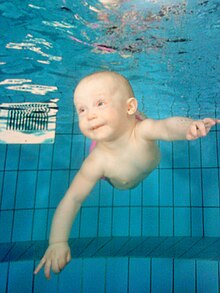

Infant swimming is the phenomenon of human babies and toddlers reflexively moving themselves through water and changing their rate of respiration and heart rate in response to being submerged. The slowing of heart rate and breathing is called the bradycardic response.[1] It is not true that babies are born with the ability to swim, though they have primitive reflexes that make it look like they are. Newborns are not old enough to hold their breath intentionally or strong enough to keep their head above water, and cannot swim unassisted.
Most infants, though not all, will reflexively hold their breath when submerged to protect their airway and are able to survive immersion in water for short periods of time.[2] Infants can also be taken to swimming lessons. Although this may be done to reduce their risk of drowning, the effects on drowning risk are not reliable.[3] Babies can imitate swimming motions and reflexes, but are not yet physically capable of swimming.
A submersion of the head may last only a few seconds.[4] A German physician pointed out the health risks of infant diving and the sometimes serious consequences as early as 1986, writing that since the introduction of baby swimming in Germany, several hundred infants had died from brain complications as a result of sinusitis and otitis that occurred after diving. Pediatricians also reported cases of cardiac arrest or respiratory failure.[5]
- ^ Goksor, E.; Rosengren, L.; Wennergren, G. (2002). "Bradycardic response during submersion in infant swimming". Acta Paediatr. 91 (3): 307–312. doi:10.1111/j.1651-2227.2002.tb01720.x. PMID 12022304. S2CID 22213714.
- ^ Pedroso, FS (February 2012). "The diving reflex in healthy infants in the first year of life". Journal of Child Neurology. 27 (2): 168–71. doi:10.1177/0883073811415269. PMID 21881008. S2CID 29653062.
- ^ Hassal, IB (1989). "Thirty-six consecutive under 5 year old domestic swimming pool drownings". Australian Paediatric Journal. 25 (3): 143–6. doi:10.1111/j.1440-1754.1989.tb01438.x. PMID 2764836. S2CID 31472695.
- ^ Birgit Kienzle-Müller, Gitta Wilke-Kaltenbach: Babys in Bewegung. Urban & Fischer in Elsevier, 2015, page 26.
- ^ Hans Rieckert: Sportmedizin - Kursbestimmung. Deutscher Sportärztekongress, Springer Verlag Berlin/ Heidelberg, Oktober 1986, page 63–64.